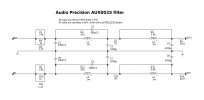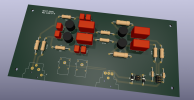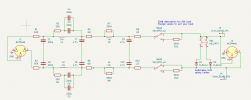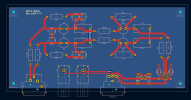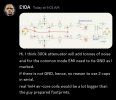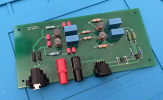Update March 2024:
Version 2 of the board is available at https://github.com/mattclarkdotnet/aes17_filter_25/tree/v2
v1 had good performance that equalled the AP SYS-AUX-0025. With the help and feedback of @sarieri @Hipocrates and others V2 aims to improve high power handling, tighten tolerances, make the PCB more compact, and reduce the 3rd harmonic distortion below -136dB. Other changes are listed in the readme file on GitHub. Nobody's built and tested v2 yet, but it should happen some time in March. The circuit is the same so there's not much risk in going for v2 now if you want to build one.

Original post:
I'm a software guy by profession, so looking for help from the hardware peeps! The backstory is that I promised here a few months ago to test a 4 channel TPA3255 module when I received it, and realised I need a decent filter for class D testing. And a voltage divider. And over voltage protection for my ADC. And load switching. And other stuff probably.
Now I can't afford an Audio Precision filter, let alone an analyser, so I thought I'd spec out something that could be ordered as an assembled PCB from JLCPCB.
The AP AUX-0025 specs as read off the graph on the AP website are approximately:
* -20dB @ 150kHz
* -40dB @ 200kHz
* -60dB @ 250kHz
* 20-40kHz deviation < 0.1dB
We can get pretty close with a 5th order Legendre filter, with variation below 35kHz < 0.1dB for a 100kOhm load. At ADC input impedances around 10kOhms this widens to ~0.3dB.
After some mucking around with CircuitLab I got this: (all series resistances are modelled in the params for the inductors and caps)
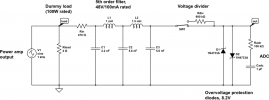
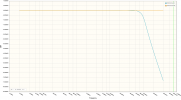
Does this have a hope in hell of working?
Version 2 of the board is available at https://github.com/mattclarkdotnet/aes17_filter_25/tree/v2
v1 had good performance that equalled the AP SYS-AUX-0025. With the help and feedback of @sarieri @Hipocrates and others V2 aims to improve high power handling, tighten tolerances, make the PCB more compact, and reduce the 3rd harmonic distortion below -136dB. Other changes are listed in the readme file on GitHub. Nobody's built and tested v2 yet, but it should happen some time in March. The circuit is the same so there's not much risk in going for v2 now if you want to build one.
Original post:
I'm a software guy by profession, so looking for help from the hardware peeps! The backstory is that I promised here a few months ago to test a 4 channel TPA3255 module when I received it, and realised I need a decent filter for class D testing. And a voltage divider. And over voltage protection for my ADC. And load switching. And other stuff probably.
Now I can't afford an Audio Precision filter, let alone an analyser, so I thought I'd spec out something that could be ordered as an assembled PCB from JLCPCB.
The AP AUX-0025 specs as read off the graph on the AP website are approximately:
* -20dB @ 150kHz
* -40dB @ 200kHz
* -60dB @ 250kHz
* 20-40kHz deviation < 0.1dB
We can get pretty close with a 5th order Legendre filter, with variation below 35kHz < 0.1dB for a 100kOhm load. At ADC input impedances around 10kOhms this widens to ~0.3dB.
After some mucking around with CircuitLab I got this: (all series resistances are modelled in the params for the inductors and caps)


Does this have a hope in hell of working?
Last edited:

